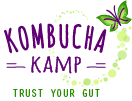Brewing Process FAQ
What kind of tea is best for Kombucha?
Almost any kind of actual tea, camelia sinensis, provides the nitrogen and nutrients Kombucha requires to thrive. Hannah’s Special Blend a combination of special black, green and white teas, blended with a few other ingredients to boost certain flavors and properties. I also make special blends for specific needs such as cleanses and other body boosts.
Is there is an ideal temperature for brewing Kombucha?
The best temperature range is 75-85°F (24-29°C), 80°F (27°C) is ideal – if it is much hotter you may consider placing it in a dark, cool cupboard. Much cooler may require insulation (in the form of an old blanket or sweater) or a heating mat.
How long should I ferment my brew? Can I ruin a brew or my SCOBY if I let it ferment too long?
You should brew as long as it takes to reach the flavor you most prefer. This may take a couple of brewing cycles to determine. Follow your taste buds. And no, you cannot “ruin” a SCOBY through long brewing cycles, though your brew will grow quite tart and eventually turn into Kombucha vinegar, which can be used in many ways if it is no longer drinkable.
What do I do with the SCOBY and liquid when making the new batch?
Remove the culture and liquid to a separate glass container while making the sweet-tea nutrient solution. The culture and starter liquid will be the very last things you add to the cooled down tea. Then cover with the cloth and secure with the rubber band.
How do I know when the kombucha is ready to bottle?
Taste is your best guide. Use a straw to gently poke under the SCOBY and take a sample after 5-7 days. Adjust longer or shorter to your preference. Part of the joy of brewing Kombucha is the process, the experimentation, and the perfecting of your own favorite flavor.
How long should I wait before I make another batch? What do I do with the SCOBY in between brews?
I usually start the next batch the same time as I bottle the completed one. That way I have a constant supply of Kombucha brewing. Always keep the culture submerged in mature KT. You need at least a cup of starter liquid for the next batch anyway, so if you plan to wait to brew again, use that.
Do the tea and sugar have to be organic?
I recommend organics because then you aren’t consuming whatever pesticide or chemical residues that might still exist in the sugar or tea – but if they are too expensive or difficult to obtain, then regular white sugar and Lipton’s tea works as well.
My last batch wasn’t carbonated and was sweeter. What can I do?
If the air temperature has cooled, you may need to ferment longer. Learn your brewing cycle by doing. For more carbonation, you could add flavors to spark secondary fermentation. However, perfecting the brewing cycle should generate subtle, natural carbonation without additional flavoring. Those bubbles may not mimic the intensity of man made ones, but they are occurring naturally.
What “dark ventilated places” can you suggest for brewing?
The pantry, a high shelf, behind a curtain. Avoid under the sink (too damp) or high traffic areas (too much vibration).
My container is about 2 gallons in size. Can I brew a 2 gallons Kombucha at a time?
Yes, just double the recipe. That means 2-4 regular SCOBYs and 2 cups of mature KT, or else the brewing cycle will be much longer than normal. Consider Continuous Brewing.
I am using a 3 gallon glass jug that is about 12 inches wide. The first batch was very vinegary after 9 days, and my second batch tastes almost perfect at 5 days. The average temperature has been in the high 60’s to low 70’s. Normal?
Volumetrics at work. Because of the larger surface area (12 inches) of your vessel, the brew will ferment faster because a greater amount of exposure to the air. If you use a vessel with a smaller surface area (I use gallon size pickle jars mostly) then you can brew longer without having such a sour taste. Also, you could try doing a continuous brew method.
I was looking online on how to make vinegar. The way they describe the Mother, it almost sounds like a SCOBY. Are they the same?
Vinegar is made by a similar process to Kombucha – however their nutrient solution and culture are different from Kombucha’s. While vinegar has MOV (mother of vinegar), the unique bacteria and yeast combo are what set Kombucha apart.
My Kombucha has brewed for 3 wks but has developed no scoby. It’s winter and our room temp is kept at 63 degrees. Is that too cold?
It is most definitely too cold for your Kombucha. The ideal brewing temp is 74-80 degrees F. I recommend purchasing a heating pad – we designed the perfect ones for Kombucha ourselves.
Do I need a stove for brewing?
You do not need a stove if you have an electric tea kettle.
How long should I allow the Kombucha to ferment?
Grab a straw or small cup to grab a taste. If it is to your liking, then it is ready. If you feel it still tastes too sweet, then give it another day or 3. Trust your palate. It will let you know.
